Last updated on March 21st, 2022
Our site is reader supported, this means we may earn a small commission from Amazon and other affiliates when you buy through links on our site.
There are many types of Chrysanthemums but the hardier perennial types flower between September and October and should be planted between April and May. To be clear, even the hardy varieties only grow in milder parts of the UK and usually need to be brought indoors into a greenhouse over winter and planted out again in spring. They need a great deal of sun and at full maturity, with that sun they will span between 10cm in height, however, taller varieties can reach as tall as 1.5 metres in height and spread and usually make good choices for cut flowers.
There are many forms of Chrysanthemums as classified by the National Chrysanthemum Society. Certain varieties are easier to grow than others. Late Chrysanthemums, for example, have to be grown specifically under glass in a greenhouse in order for them to flower later in the season. Things can get technically quite complicated if you choose the more difficult varieties to grow so make sure to do your research before you head off to the local nursery and buy whatever variety you see first.
Early Chrysanthemums are the best option for beginners as well as the taller growing specimens and these Chrysanthemums are typically grown for the cut flowers they produce. If you are growing indoors or in a border, you can choose dwarf varieties that can do well all year round in a more mild climate. If you live in a cooler area that gets quite cold in the winter (which is most parts of the UK) you may need to lift your Chrysanthemums out of the ground and protect them during the winter.
Planting Chrysanthemums
Plant outdoors in May when the risk of frost has passed or around April if you place them in a cold frame.
If you have grown your own plants in the past and saved them over winter, or taken cuttings from an existing plant and have prepared them for transplanting, wait until the month of May (depending on the weather in your area) before planting them into your garden. If you want to put them outdoors a little sooner you can place plants in a cold frame outdoors from around mid-April once the worst of the weather has passed. We recommend digging in any homemade compost you may have or other organic compost, you can also mix in some growmore or fish blood and bone before planting.
Learn more about whether Chrysanthemums are perennials or annuals by reading our article here.
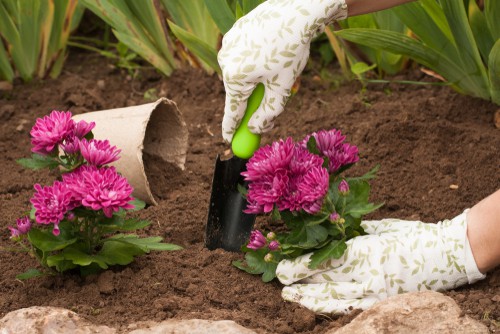
Planting cuttings
If you have purchased rooted cuttings from a plant nursery, you want to plant them in pots that are 9cm pots with soil-free compost as soon as possible and then place them somewhere they are free from frost damage but will receive ample light. If you purchase larger plants they may be ready to go directly into the garden but you might have to wait until the middle of May when the danger of frost has passed.
Planting outdoors
When it is time to put your Chrysanthemums outside you need to plant them somewhere that is bright and sunny but sheltered, especially the taller types that also need caning. The soil should be well-drained soil that has had a little bit of fertiliser and compost mixed into it, a bucket of compost per square metre should be enough with some growmore or fish, blood and bone forked in.
When planting more than one Chrysanthemum space them approximately 20cm apart depending on the variety. As soon as you are finished planting water them generously for the first one or two weeks while the Chrysanthemums get themselves established.
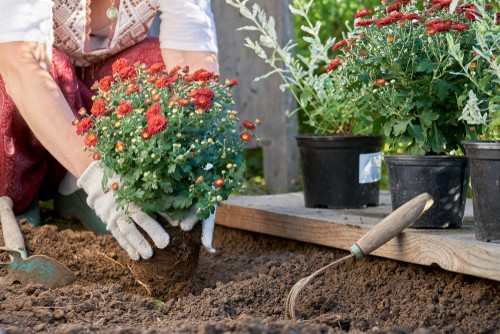
Apply a top drilling of fertiliser in June
It is beneficial to give a top dressing of a nitrogen-rich fertiliser in June so that you can encourage better growth right from the beginning. We recommend using chicken manure pellets which are available from most garden centres and even online.
General Chrysanthemum Care
Once you have planted your Chrysanthemum successfully all you really need to do is tend to their growth early on so they grow into the size and shape you prefer. Give them some support against the wind once they reach full maturity using canes, and prepare them for winter.

Disbudding
With spray Chrysanthemums, you want strong plants, not spindly ones that are short and stocky with lots of flower buds. Once your plants reach about 20cm tall, it’s time to pinch out the tops, removing that layer of top growth and bringing the plant down to three or four sets of leaves from the base of the plant. This is done to encourage the formation of side shoots which results in a bushier and the more floriferous clump of flowers that you commonly see on Chrysanthemums. You will often find them on sale around Mother’s Day in pots where they are full of flowers.
This is a process that can benefit you if you want to take cuttings as well because the pieces you have removed can be used. We discuss taking cuttings in more detail a little further down.
If you have a Chrysanthemum that you prefer to grow in a large single flower you can grow the large, single blooms as opposed to the sprays. With this, you want to do the opposite technique, one that is similar to how you would train a tomato plant, in so far as you remove all of the side shoots rather than the growth so that you can create a single, strong stem like that of a standard.
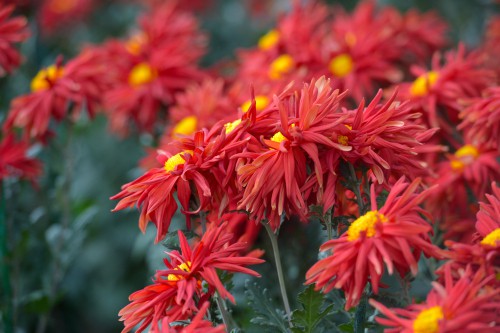
Stake taller varieties to protect them from strong winds
Taller Chrysanthemums will break at the base at times, very similar to Dahlias, so it’s important to stake them in advance. Once your Chrysanthemums reach their peak height, the wind and rain from autumn will be well on their way. So the garden stakes you use should be tall enough to accommodate your Chrysanthemum but just short enough that your flowers are able to stand above it. You can tie them individually to their own stake or you can grow an entire bed with netting that is stretched horizontally from one stake to another, end-to-end, and approximately 40cm off the ground. This is a technique we actually learned from www.sarahraven.com.
Storing Plants Over Winter
When the weather starts to turn a bit colder it is a good idea to lift the Chrysanthemums and bring them into a greenhouse if you want to keep them to plant out again the following year. This will also help you to sustain flowers well into Christmas.
In order to overwinter your Chrysanthemums, you want to cut them back to the main stem to approximately 20cm from the ground. Most Chrysanthemums that are considered early Chrysanthemums have a hardness rating that allows them to remain in the ground with temperatures of -5°C. So if you live in an area where it doesn’t get colder than that you can leave them outside by covering them with some organic matter such as a layer of protective mulch, bark chips, or homemade compost, however, they obviously won’t produce flowers until Christmas. If it does get colder you will need to lift them and store them in a cool conservatory or greenhouse.
Preparing plants for winter
When preparing for overwintering lift the plants after you have cut them back and remove any surplus soil from between the roots. Clean up the roots and the plant by removing any green leaves or shoots so that all you have left are the stems cut back now to approximately 8cm. If you are growing multiple varieties it is best to label them when you overwinter them because at this stage they will all look the same.
Place each of the plants in a shallow tray on top of approximately 5cm of compost and then cover the roots with compost lightly. Do not water them but simply keep them cold in your conservatory or your greenhouse. Periodically throughout the winter, you can keep the compost moist by giving them a light watering.
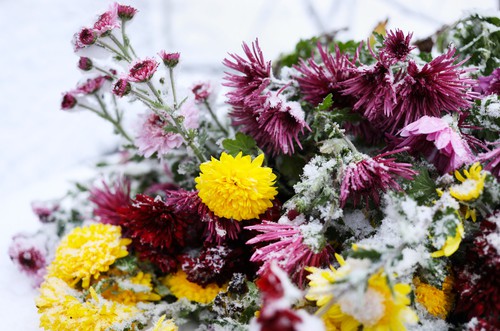
When the flowering is done you can dry off your Chrysanthemums, cut them down, and store them somewhere free from frost. The roots will start to grow again in the spring so you can re-pot them and start all over.
Propagating Chrysanthemums
Propagating by seed
There are several methods you can use to propagate Chrysanthemums. The first is with seeds. There are some Chrysanthemums that are available in the form of seeds. You should put these in the ground once it reaches 15°C outside and they will germinate in about two weeks.
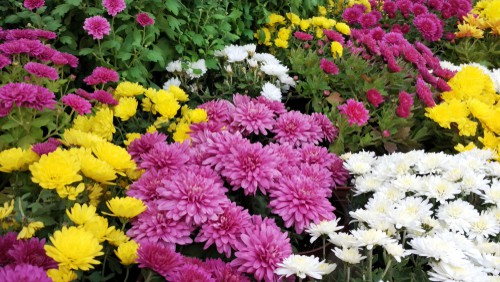
Propagating by dividing
The second method is through division. If you have specific plants you can use the old roots and divide them in spring. Effectively you take the roots you have stored over winter and once spring comes and new growth appears, divide the roots into multiple plants and then go about planting as you normally would.
Taking cuttings
As mentioned you can also use your disbudding as an opportunity to take cuttings. In the spring, you can take cuttings as close as possible to the crown, approximately 6-7cm in length.
Bring overwintered plants in to take cuttings
In order to bring on plants to take cuttings from, in January bring your overwintered plants into a moderately heated greenhouse or conservatory, around 7-10°C (45-50°F) is ideal. Water the trays so that the compost is moist, and within about one month you should see strong basal shoots with good top growth, ready for taking cuttings.
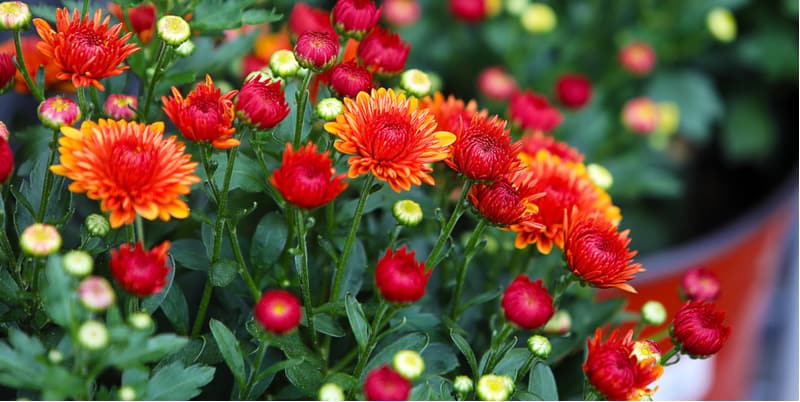
You can take usually take cuttings from the middle of February onwards. Conversely, you can use the method mentioned above where you trim back your existing plants and if the cuttings you have taken are long enough, propagate them in a container until they have established roots and are strong enough to go into the ground or into a pot.
To learn more about taking cuttings from Chrysanthemums, read our detailed guide here
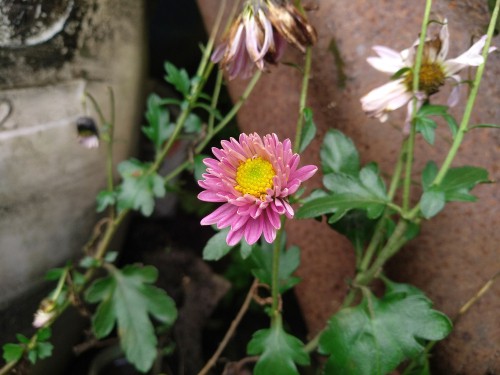
Chrysanthemum Pests and Diseases
Pests to watch out for
In terms of pests, Chrysanthemums will fall victim to aphids (as most plants do) and leafminers. Sometimes you might have problems with leaf and bud eelworms if your plant has not been properly heat-treated. The blooms can also be damaged in the autumn by earwigs. On occasion, you will find red spider mites or capsid bugs. All of these can be easily treated with commercial pesticides as soon as you notice them.
It is, of course, best if you can employ preventative measures, one environmentally friendly way to help prevent common pests like aphids, is to invest in ladybirds. Believe it or not, you can actually buy these online and they will eat away most of these pests. Of course, if you do see them on your Chrysanthemums, and you don’t want to use a pesticide, you can always spray them away with soapy water but make sure that you spray every part of your plant because even a few aphids left hiding under a leaf can come back and do severe damage.
Diseases
In terms of diseases, rust can be very damaging and incredibly difficult to maintain, especially Chrysanthemum white rust. Another issue is powdery mildew if you have dry conditions. If you have wet conditions and improper drainage it can lead to fungal rot or mould which, left unattended will become incredibly damaging. With this in mind, you should make sure there is proper drainage before you plant and always check on the drainage situation in wet conditions as well as remove any affected growth as soon as you notice it.
Growing Chrysanthemums Indoors
Find suitable varieties
If you are growing Chrysanthemums indoors you need to find the right variety. There are certain varieties that are best grown in a greenhouse and these include plants such as Froggy, Porto Purple and Anastasia Green.
Growing in a greenhouse
If you have a greenhouse with soil beds in them you can directly plant the rooted cuttings, spacing them about 35cm apart and watering them well. Pinch them out and stake them the same way you would with an outdoor variety. That is to say that you can give them individual stakes to help them as they become fully established or you can put stakes in from one end of your soil bed to another with netting on top approximately 35cm in height so that they can grow through it.
Pinching out plants
You can choose to pinch off the flower heads, leaving just three or four sets of leaves from the base upwards so that your plants focus their energy on cultivating side shoots to create a bushier effect. Conversely, you can pinch them off the same way you would a tomato plant, removing the side shoots so that the energy goes into creating a single, strong stem with one flower on top.
Growing in pots indoors
Alternatively, you can grow them in large pots that are between 35cm and 40cm in diameter. With large pots, you can keep them indoors and then move them outside if the weather is good. Fill the pots with compost and put one Chrysanthemum plant per pot. Water them well and add a garden stake to give them support as they grow. Once the frost is over you can move the pots outside so that they are sitting somewhere sunny but sheltered, and pinch them out the same way you would for any other outdoor variety to encourage a bushy plant or to encourage single stems.
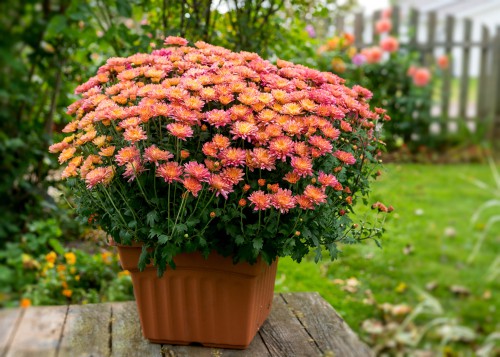
Water them freely during the summer with a balanced fertiliser every two weeks until the time that the flower buds begin to appear. Once we get to September, bring the pots back inside to protect them from bad weather and continue picking flowers from inside your greenhouse.
Overall, Chrysanthemums are not necessarily a difficult plant to grow as long as you choose early bloomers as opposed to late bloomers. Once you have successfully grown Chrysanthemums for a few years and have honed your skills as a gardener you can always make the leap into the more difficult late flowering varieties and try your luck at growing the blooms under glass to provide flowers all year round using artificial light and heat.


